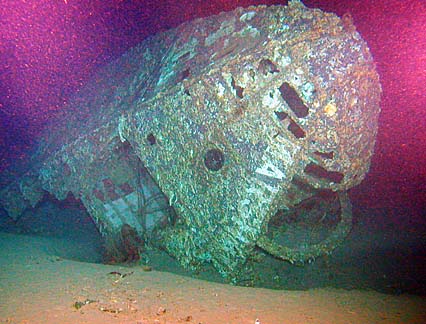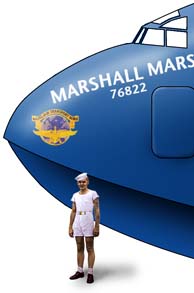
|

A sunken seaplane discovered
by UH scientists sheds light on
Hawaii's postwar naval history
The deep-diving scientists of the Hawaii Undersea Research Lab discovered a midget off Pearl Harbor a couple of years ago, and now they've uncovered a giant.
Martin JRM-1 MarsWingspan: 200 feetLength: 117 feet 3 inches Height: 38 feet 5 inches Empty weight: 75,573 pounds Maximum speed: 221 mph Range: 4,945 miles Armament: none Crew: 11
|
"It was enormous, but it was lying flat on the hard bottom just sticking up a few feet and there was no way it could have been buried that deeply," said Kerby. "Nearby, we found the nose of the aircraft with the word 'Marshall' written on it. We had no idea what it was."
Late last week, on a return survey sponsored by the National Oceanic and Atmospheric Administration's Office of Ocean Exploration, the team confirmed the discovery. The wreck is that of the gigantic seaplane Marshall Mars, one of the largest aircraft ever built, and part of a trans-Pacific U.S. Navy transport service after World War II.
Marshall Mars once carried more than 308 people aloft, a record at the time and headlined by one newspaper as "Mars Is Well-Inhabited."
In the spring of 1950, during a test flight off of Diamond Head, one of Marshall Mars' engines caught fire, and the pilot landed in the open ocean. Although the crew got out safely and a fireboat was soon on the scene, the plane burned, exploded and sank. The cause was thought to be a leaking fuel line, although it could not be confirmed because the wreckage vanished, swallowed by the ocean.
"The flattened keel makes sense now that we know she burned almost to the waterline," said Kerby. "We began to suspect she was the Marshall Mars when HURL researcher Steve Price found a great photo of the plane with a hundred sailors standing on the wing. Right on the nose you can see the plane's name."
On the return dive, Kerby maneuvered near bent and corroded aluminum aircraft debris, still streaked with traces of dark blue paint. "Then we came upon a huge engine, nose in to the bottom," said Kerby. "Further on, we saw propellers sticking up, some straight, some twisted, and as we turned the sub, we saw the propellers were attached to a second huge engine that was still on the wing. And then we discovered a third engine. We knew we'd found the main body of Marshall Mars."
"Submerged historic wreck sites are like time capsules from our maritime past," said NMSP maritime archaeologist Hans Van Tilburg. "In this case, naval aircraft sites shed light on our technological capabilities both before and during World War II. Seaplanes and flying boats played a critical role in Hawaii and the Pacific."
The gigantic flying boats made an impression on anyone who flew in them. Aviation radioman George Hutton flew in four of the five Mars seaplanes, including Marshall Mars.
"She was a fine flying boat," he recalled to NOAA officials, "but takeoff and landing could be a little hairy, depending on the seas."
During one port visit, he walked out on the Mars' 200-foot wing. "It was like a football field," he said.

A Marshall Mars, part of a trans-Pacific U.S. Navy transport service after World War II, once carried more than 308 people aloft.
Craft took names
of island chains
In the days following the Pearl Harbor attack, with German and Japanese submarines threatening shipping off American coasts, industrialist Henry J. Kaiser suggested that his shipyards construct hundreds of gigantic flying boats to supply forces overseas.
Kaiser eventually teamed up with Howard Hughes and built the Spruce Goose to prove the concept.
Another team, led by Glenn Martin's aircraft company, followed a parallel track. Enormous seaplanes were an obsession with the designer -- Martin built Pan Am's China Clipper in the mid-1930s -- and his engineers modified their Sky Battleship XPB2M-1 into a pure transport.
The prototype aircraft was named the Martin Mars and pressed into active duty in late 1943. One of her first flights was a 4,700-mile round-trip to Hawaii, carrying a load of 20,500 pounds in 27 hours, 26 minutes.
The giant aircraft flew continuously for the duration, leading Martin to announce that the "Mars is the most efficient airplane in the world, per pound of weight, per horsepower and per gallon of fuel consumed. She has also proven herself one of the safest."
The Navy was impressed and ordered 20, now coded the JRM-1. War's end curtailed production at six airframes, named after Pacific island chains. One of them was the Hawaii Mars, which crashed in a landing during flight tests.
The Mars was the largest-capacity production aircraft prior to the introduction of the Boeing 747, and distinguished itself during the Korean War as a trans-Pacific transport, carrying 134 seated troops or 84 stretcher patients and 25 medics per flight.
The Navy retired the Mars in 1956, and all four remaining airframes were purchased by British Columbia-based Forest Industries as flying tankers. Marianas Mars crashed in an accident in 1961, and Caroline Mars was destroyed in a typhoon a year later.
Nearly 60 years after they were built, both the Philippine and Hawaii Mars 2 are still working, dropping 7,000-gallon loads of water on West Coast forest fires.
[News] [Business] [Features] [Sports] [Editorial] [Do It Electric!]
[Classified Ads] [Search] [Subscribe] [Info] [Letter to Editor]
[Feedback]

